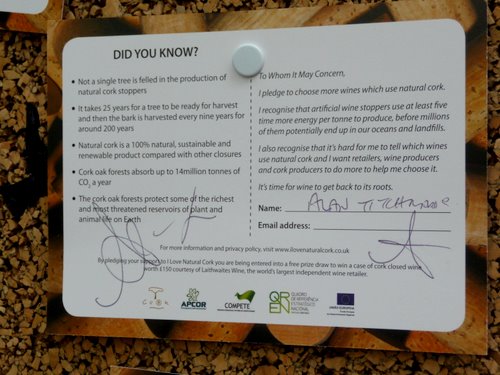I had a meeting this morning at Clarence House, the home of the Prince of Wales, so afterwards I wandered down to take a peek at the ‘Start’ Garden Party to Make a Difference, which is being held over the next few days here (see the website for more details).
The idea of Start is to get people to begin thinking about ways they can be more environmentally friendly. One of the exhibits, pictured above, is a set of four giant corks. The idea is to educate consumers about the environmental benefits of cork, and the sustainability of the cork forests. They are encouraged to sign a pledge for cork and stick it onto one of the giant corks (in the picture above there are only a few of these so far affixed; this is because it is the first day of the festival).
Pictured below is the pledge signed by Alan Titchmarsh. [Anyone living near him should check his recycling to make sure there are no more screwcapped wine bottles being consumed in the Titchmarsh household.]
I was asked whether I’d sign a card and make the pledge. I politely declined the offer.
7 Comments on Making a pledge for cork




I don’t have a problem with any of the statements being made; they are all probably quite true. However, they are not really dealing with the issue. As a producer, the issue is the estimated 1 in 12 (8%) failure rate due to TCA or “cork affected” (often the figure is higher) that I become financially responsible for and the unreported problems that have an almost incalculable effect on your brand!
The ideal closure will always be a great cork; it’s the “great” that is the problem!
Lorraine, I am in full agreement with you – my pledge is to support closures that are consistent and taint free!
I much prefer cork myself. Hate screwcaps.
I do like those sexy glass stoppers though.
Lorraine – Can you please back up that “estimate” with some accredited references?
Don’t mean to pick on you. I’m closure agnostic and think they all have their place and pro’s and con’s. I’m just getting a little tired of the silly numbers and hyperbole that keep getting thrown around when cork gets talked about. The producers I’ve talked to recently put the real world taint at ~1-2%. No recent study I’ve read to date nor real world experience I’ve had show any figure even close to that. Obviously there may be some difference between those who buy the cheapest and those who pay for quality.
Jamie,
I can understand why you declined to sign. The cork industry is not as clean as it might seem. Funny, I was republishing my old article “Recipe for a good cork”, and your post appeared on RSS… So I included a link to your article. http://www.thewineblog.net/2010-09-recipe-for-good-corks/
cheers
Mike
Stefan, I think you will find the level Lorraine is quoting is potentially even higher than 8%. Many other bottles just taste ‘not quite right’, and cork issues, usually low levels of TCA, are often to blame. There is strong anecdotal evidence, especially in Australia, that cork taint is above 10%. Hence the overwhelming move to screwcap closures in Oz.
Stefan, you are right in that there is a lot of hyperbole regarding the incidence of cork affected wine and, to be fair, my figure of 8% is based on my personal experience (8% represents 1 bottle from every case of wine)and many, many discussions (pers com) with Southern Hemisphere winemakers so you could argue that my while figure may not be truly objective, I would argue that it is based on fact. AWRI would suggest that the true figure may be around 5%. We had a huge problem a wine from the 2003 vintage where I would estimate, from tasting that one particular wine, it was 20 – 25% affected. When you know a wine well you know when it is not tasting ‘quite right’ and you open another bottle and discover that the first has been scalped but maybe not showing obvious characters of cork taint. The problem with this is that while a customer may not recognise that the wine has been cork affected they do not like the wine. These are the unreported and incalculable cases that I mentioned above. This was a red wine and it was at this point that we went to screwcap for our full bodied reds. It felt like we were conceding defeat!
Prices of cork have little to do with the eventual incidence of cork taint. When we bought corks we always bought the highest or second highest grade. Grading of corks is often a visual grade.
It is interesting to note that when it comes to a visual assessment of corks we pull from European and American wines we rarely see corks of that quality here in NZ.
I am all for great corks as a wine closure but there is a lot of ground to be regained before many Southern Hemisphere winemakers will have the confidence to return completely to corks. (There is of course the price factor for certain price point wines that will probably never see corks again)